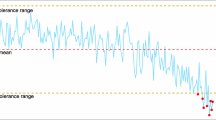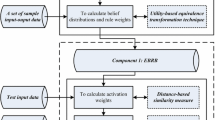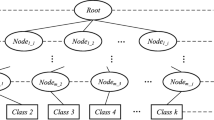Abstract
In current researches on belief rule base (BRB), input parameters are tended to be expressed in the form of quantitative values through expert knowledge combined with optimization methods. A singular quantitative value fails to capture the statistical properties, leading to irrational outcomes. Therefore, an attempt on attribute weights is made in this paper, and a new model with probability distribution attribute weights (pdw) called BRB-pdw is proposed. The combination of two attributes is in detail discussed, where attribute weights are described as random variables with specific probability distribution. To characterize the output of probability distribution attribute weight, a new concept of expectation of activation weight is proposed. In addition, the BRB-pdw is extended to multiple attributes to demonstrate its universality. Furthermore, fundamental properties and characteristics of the BRB-pdw are further validated by rigorous mathematical derivation. Finally, practicability of the BRB-pdw is validated with NASA lithium battery open dataset, and experiments show that the BRB-pdw model is more robust while maintaining precision.
















Similar content being viewed by others
Data availability
No datasets were generated or analyzed during the current study.
References
Zadeh LA (1965) Fuzzy sets. Inf Control 8(3):338–353
Ayadi H, Torjmen-Khemakhem M, Huang JX (2023) Term dependency extraction using rule-based bayesian network for medical image retrieval. Artif Intell Med 140:102551
Chang LL, Zhang LM, Fu C, Chen YW (2022) Transparent digital twin for output control using belief rule base. IEEE Trans Cybern 52(10):10364–10378
Yang JB, Singh MG (1994) An evidential reasoning approach for multiple-attribute decision making with uncertainty”. IEEE Trans Syst Man Cybern 24(1):1–18
Yang JB, Liu J, Wang J, Sii HS (2006) Belief rule-base inference methodology using the evidential reasoning approach-RIMER. IEEE Trans Syst Man Cybern Part A Syst Humans 36(2):266–285
Dempster AP (1968) A generalization of bayesian inference”. J Roy Stat Soc: Ser B (Methodol) 30(2):205–232
Gao F, Bi CC, Bi WH, Zhang A (2023) A new belief rule base inference methodology with interval information based on the interval evidential reasoning algorithm. Appl Intell 53:12504–12520
Cao Y, Zhou ZJ, Tang SW, Ning PY (2023) On the robustness of belief-rule-based expert systems. IEEE Trans Syst Man Cybern Syst 53(10):6043–6055
Feng ZC, Yang RH, Zhou ZJ, Chen HT (2023) Online fault diagnosis and tolerance based on multiexpert joint belief rule base for sensor failures of vehicles. IEEE Trans Instrum Meas 7:1–13
Liu ZG, Zhang XX, Niu JW, Dezert J (2021) Combination of classifiers with different frames of discernment based on belief functions. IEEE Trans Fuzzy Syst 29(7):1764–1774
Hu GX, He W, Sun C, Zhu HL (2023) Hierarchical belief rule-based model for imbalanced multi-classification. Expert Syst Appl 216:119451
Li BD, Lu J, Li J, Zhu XB (2022) Scenario evolutionary analysis for maritime emergencies using an ensemble belief rule base. Reliab Eng Syst Saf 225:108627
Cao Y, Zhou ZJ, Hu CH, He W (2021) On the interpretability of belief rule based expert systems. IEEE Trans Fuzzy Syst 29(11):3489–3503
Chen YW, Yang JB, Pan CC, Xu DL (2015) Identification of uncertain nonlinear systems: constructing belief rule-based models. Knowl-Based Syst 73:124–133
Wang J, Zhou ZJ, Hu CH, Tang SW (2022) A new evidential reasoning rule with continuous probability distribution of reliability. IEEE Trans Cybern 52(8):8088–8100
Feng ZC, Zhou ZJ, Hu CH, Chang LL (2019) A new belief rule base model with attribute reliability. IEEE Trans Fuzzy Syst 27(5):903–916
Chang LL, Zhou ZJ, Liao H, Chen YW (2019) Generic disjunctive belief-rule-base modeling, inferencing, and optimization. IEEE Trans Fuzzy Syst 27(9):1866–1880
Nimmy SF, Hussain OK, Chakrabortty RK, Hussain FK (2023) An optimized Belief-Rule-Based (BRB) approach to ensure the trustworthiness of interpreted time-series decisions. Knowl-Based Syst 271:110552
Yang JB, Xu DL (2013) Evidential reasoning rule for evidence combination. Artif Intell 205(1):1–29
Kong GL, Xu DL, Yang JB, Wang TB (2021) Evidential reasoning rule-based decision support system for predicting ICU admission and in-hospital death of Trauma. IEEE Trans Syst Man Cybern Syst 51(11):7131–7142
Tang SW, Zhou ZJ, Hu CH, Zhao FJ (2022) A new evidential reasoning rule-based safety assessment method with sensor reliability for complex systems. IEEE Trans Cybern 52(5):4027–4038
Wang J, Zhou ZJ, Hu CH, Han XX (2022) An evidential reasoning rule considering parameter uncertainty. IEEE Trans Aerosp Electron Syst 58(2):1391–1404
Yang LH, Ren TY, Ye FF, Nicholl P (2022) An ensemble extended belief rule base decision model for imbalanced classification problems. Knowl-Based Syst 242:108410
Liu WL, Wu WK, Wang YM, Fu YG (2019) Selective ensemble learning method for belief-rule-base classification system based on PAES. Big Data Min Anal 2(4):306–318
Wu J, Wang QW, Wang ZL, Zhou ZG (2022) AutoBRB: an automated belief rule base model for pathologic complete response prediction in gastric cancer. Comput Biol Med 140:105104
Tong MN, Zhao YG, Lu ZH (2021) Normal transformation for correlated random variables based on L-moments and its application in reliability engineering. Reliab Eng Syst Saf 207:107334
Rahmani B, Markazi AHD (2013) Variable selective control method for networked control systems. IEEE Trans Control Syst Technol 21(3):975–982
Gao M, Niu YC, Sheng L (2022) Distributed fault-tolerant state estimation for a class of nonlinear systems over sensor networks with sensor faults and random link failures. IEEE Syst J 16(4):6328–6337
Balesdent JGM, Tremolet A, Wuilbercq R, Melab N (2023) Hidden-variables genetic algorithm for variable-size design space optimal layout problems with application to aerospace vehicles. Eng Appl Artif Intell 121:105941
Han P, He W, Cao Y, Li YM (2023) Lithium-ion battery health assessment method based on belief rule base with interpretability. Appl Soft Comput 138:110160
Liu ZG, Pan Q, Mercier G, Dezert J (2015) A new incomplete pattern classification method based on evidential reasoning. IEEE Trans Cybern 45(4):635–646
Wang YM, Zhu G, Kwong S, Shi YQ (2018) A study on the security levels of spread-spectrum embedding schemes in the WOA framework. IEEE Trans Cybern 48(8):2307–2320
Tang SW, Zhou ZJ, Han XX, Cao Y (2023) A new evidential reasoning rule considering interval uncertainty and perturbation. IEEE Trans Cybern 53(5):3021–3034
Ye FF, Yang LH, Uhomoibhi J, Liu J (2023) Evidential reasoning rule for environmental governance cost prediction with considering causal relationship and data reliability. Soft Comput 27:12309–12327
Fu Q, Song YF, Fan CL, Lei L (2020) Evidential model for intuitionistic fuzzy multi-attribute group decision making. Soft Comput 24:7615–7635
Ye FF, Yang LH, Wang YM (2020) A cost forecast method of environmental governance based on input-output relationship and efficiency. Control Decision 35(4):993–1003
Yang LH, Wang SH, Ye FF, Liu J, Wang YM, Hu HB (2021) Environmental investment prediction using extended belief rule-based system and evidential reasoning rule. J Clean Prod 289:125661
Cheng XY, Han P, He W (2023) A new interval constructed belief rule base with rule reliability. J Supercomput 79:15835–15867
Hou K, Sun J, Guo M (2024) TentISSA-BPNN: a novel evaluation model for cloud service providers for petroleum enterprises. J Supercomput 80:9162–9193
Ikram ST, Priya V, Anbarasu B (2022) Prediction of IIoT traffic using a modified whale optimization approach integrated with random forest classifier. J Supercomput 78:10725–10756
Zhang YY, Jina E, Cao Y, Zhang W, He W (2024) Performance evaluation of complex systems based on hierarchical evidential reasoning rule considering disturbances. J Supercomput. https://doi.org/10.1007/s11227-024-06195-6
Zhou XH, Wang JP, Zhang HX, Duan QL (2023) Application of a hybrid improved sparrow search algorithm for the prediction and control of dissolved oxygen in the aquaculture industry. Appl Intell 53:8482–8502
Dinh TP, Pham-Quoc C, Thinh TN, Nguyen BKD, Kha PC (2023) A flexible and efficient FPGA-based random forest architecture for IoT applications. Int Things 22:100813
Yin XX, He W, Cao Y, Ma N, Zhou GH, Li HY (2024) A new health state assessment method based on interpretable belief rule base with bimetric balance. Reliab Eng Syst Saf 242:109744
Feng ZC, Yang RH, Zhou ZJ, Hu CH (2023) Trustworthy fault diagnosis method based on belief rule base with multisource uncertain information for vehicle. IEEE Trans Industr Electron 71(7):7947–7956
He W, Cheng XY, Zhao X, Zhou GH, Zhu HL, Zhao EK, Qian GY (2023) An interval construction belief rule base with interpretability for complex systems. Exp Syst Appl 229:120485
Wang J, Zhou ZJ, Hu CH, Han XX, Tang SW, Ning PY (2022) An evidential reasoning rule considering parameter uncertainty. IEEE Trans Aerosp Electron Syst 58(2):1391–1404
Han P, Zhang QX, He W, Chen YW, Zhao BY, Li YM, Zhou GH (2024) A double inference engine belief rule base for oil pipeline leakage. Exp Syst Appl 240:122587
Funding
This work was supported the Fundamental Research Funds for the Central Universities (No. 2024YJS015), the National Key Research and Development Program of China (No. 2022YFB3105105), and Beijing Laboratory of National Economic Security Early-warning Engineering, Beijing Jiaotong University.
Author information
Authors and Affiliations
Contributions
Yunyi Zhang contributed to conceptualization; Yunyi Zhang and Ye Du contributed to methodology; Yunyi Zhang and Wei He performed investigation; Yunyi Zhang performed writing—original draft preparation; Yunyi Zhang and Hongbin Huang performed writing—review and editing. All authors have read and agreed to the published version of the manuscript.
Corresponding author
Ethics declarations
Conflict of interest
The authors declare no competing interests.
Ethical approval
This article does not contain any studies with human participants or animals performed by any of the authors.
Additional information
Publisher's Note
Springer Nature remains neutral with regard to jurisdictional claims in published maps and institutional affiliations.
Appendices
Appendix 1
For the convenience of proof, the infer of BRB’s activation weight based on Eq. (3) can be expressed as \(G(\delta_{1} ,\delta_{2} ) = \left[ {\theta_{k} \prod\nolimits_{m = 1}^{M} {(a_{m}^{k} )^{{\overline{\delta }_{m} }} } } \right]/\left[ {\sum\nolimits_{l = 1}^{L} {\theta_{l} \prod\nolimits_{m = 1}^{M} {(a_{m}^{k} )^{{\overline{\delta }_{m} }} } } } \right]\). Meanwhile, \(f(\delta_{1} ,\delta_{2} ) = f(\delta_{1} )f(\delta_{2} )\), \(f(\delta_{i} ) = 1/(\delta_{i}^{ + } - \delta_{i}^{ - } ), \, \delta_{i}^{ - } < \delta_{i} < \delta_{i}^{ + }\).
1.1 A. Proof of Theorem 2
Proof:\(E(w_{k} )\) can be expressed in the following form:
According to the property of BRB, \(0 \le G(\delta_{1} ,\delta_{2} ) < 1\) can be obtained. Based on the property of the PDF, there is
The following relationship can be obtained
Then, we can get
Therefore, it can be proven that \(E(w_{k} )\) is bounded and always lies within the interval \([0,1)\). The lower bound of \(E(w_{k} )\) is 0, while the upper bound of \(E(w_{k} )\) needs to be computed specifically based on numerical analysis.
1.2 B. Proof of Theorem 3
Proof: The cumulative sum of \(E(w_{k} )\) for \(L\) rules can be profiled by
as mentioned in Theorem 2 for \(\int_{{\delta_{1}^{ - } }}^{{\delta_{1}^{ + } }} {\int_{{\delta_{2}^{ - } }}^{{\delta_{2}^{ + } }} {f(\delta_{1} ,\delta_{2} )} } d\delta_{1} d\delta_{2} = 1\), Eq. 56 can be rewritten as
Since \((\delta_{1}^{ + } - \delta_{1}^{ - } ) > 0\) and \((\delta_{2}^{ + } - \delta_{2}^{ - } ) > 0\) always hold, there is \(\sum\nolimits_{k = 1}^{L} {E(w_{k} )} > 0\). Since \(\delta_{1} \in [\delta_{1}^{ - } ,\delta_{1}^{ + } ], \, \delta_{2} \in [\delta_{2}^{ - } ,\delta_{2}^{ + } ]\), when \(\delta_{1}^{ - } = \delta_{2}^{ - } = 0\), \(\delta_{1}^{ + } = \delta_{2}^{ + } = 1\), there is \(\sum\nolimits_{k = 1}^{L} {E(w_{k} )} \equiv 1\). When \(\delta_{1} \in (0,1), \, \delta_{2} \in (0,1)\), there is \(\sum\nolimits_{k = 1}^{L} {E(w_{k} )} < 1\). Therefore, \(0 < \sum\nolimits_{k = 1}^{L} {E(w_{k} )} \le 1\) is always satisfied.
1.3 C. Proof of Theorem 4
Proof: Suppose that \(m\) and \(M\) are lower and upper bounds on \(G(\delta_{1} ,\delta_{2} )\), because \((\delta_{1}^{ + } - \delta_{1}^{ - } )(\delta_{2}^{ + } - \delta_{2}^{ - } ) > 0\), the following inequality can be obtained
According to the property of double integration, there is
where
Therefore, \(m \le E(w_{k} ) \le M\) can be proven. Hence, \(E(w_{k} )\) is a definite value within the interval \([m,M]\), and \(G(\delta_{1} ,\delta_{2} )\) is a continuous function. According to the intermediate value theorem for continuous functions on a closed interval, there must be at least one point \((\delta_{\tau 1} ,\delta_{\tau 2} )\) such that \(G(\delta_{\tau 1} ,\delta_{\tau 2} ) = E(w_{k} )\). Theorem 4 is proved.
Appendix 2
For \(\partial p_{n,e(L)} /\partial E(w_{k} )\), when each rule is complete, \(\sum\nolimits_{j = 1}^{N} {\beta_{j,i} } \equiv 1\) can be obtained. Therefore, \(\sum\nolimits_{j = 1}^{N} {\beta_{j,i} } \equiv 1\) has no effect on calculation result of the partial derivative, and the output belief degree \(p_{n,e(L)}\) can be abbreviated as
Let \(p_{n,e(L)} = (A - B)/(C - D)\), then the partial derivative of \(A,B,C \, and{\text{ D }}\) with respect to \(E(w_{k} )\) is
Therefore, \(\partial p_{n,e(L)} /\partial E(w_{k} )\) can be calculated as follows:
For \(\partial E(w_{k} )/\partial \delta_{i}^{ + }\), first calculate \(\partial E(w_{k} )/\partial \delta_{1}^{ + }\), and there is
According to the definition of the derivative of an integral, \(\partial E(w_{k} )/\partial \delta_{1}^{ - }\) can be calculated by
Similarly, \(\partial E(w_{k} )/\partial \delta_{2}^{ + }\) can be calculated by
\(\partial E(w_{k} )/\partial \delta_{2}^{ - }\) can be calculated by
In view of this, \(\partial E(w_{k} )/\partial \delta_{i}^{ + }\) can be calculated iteratively.
Rights and permissions
Springer Nature or its licensor (e.g. a society or other partner) holds exclusive rights to this article under a publishing agreement with the author(s) or other rightsholder(s); author self-archiving of the accepted manuscript version of this article is solely governed by the terms of such publishing agreement and applicable law.
About this article
Cite this article
Zhang, Y., Huang, H., Du, Y. et al. On the continuous probability distribution attribute weight of belief rule base model. J Supercomput 80, 23225–23270 (2024). https://doi.org/10.1007/s11227-024-06363-8
Accepted:
Published:
Issue Date:
DOI: https://doi.org/10.1007/s11227-024-06363-8




